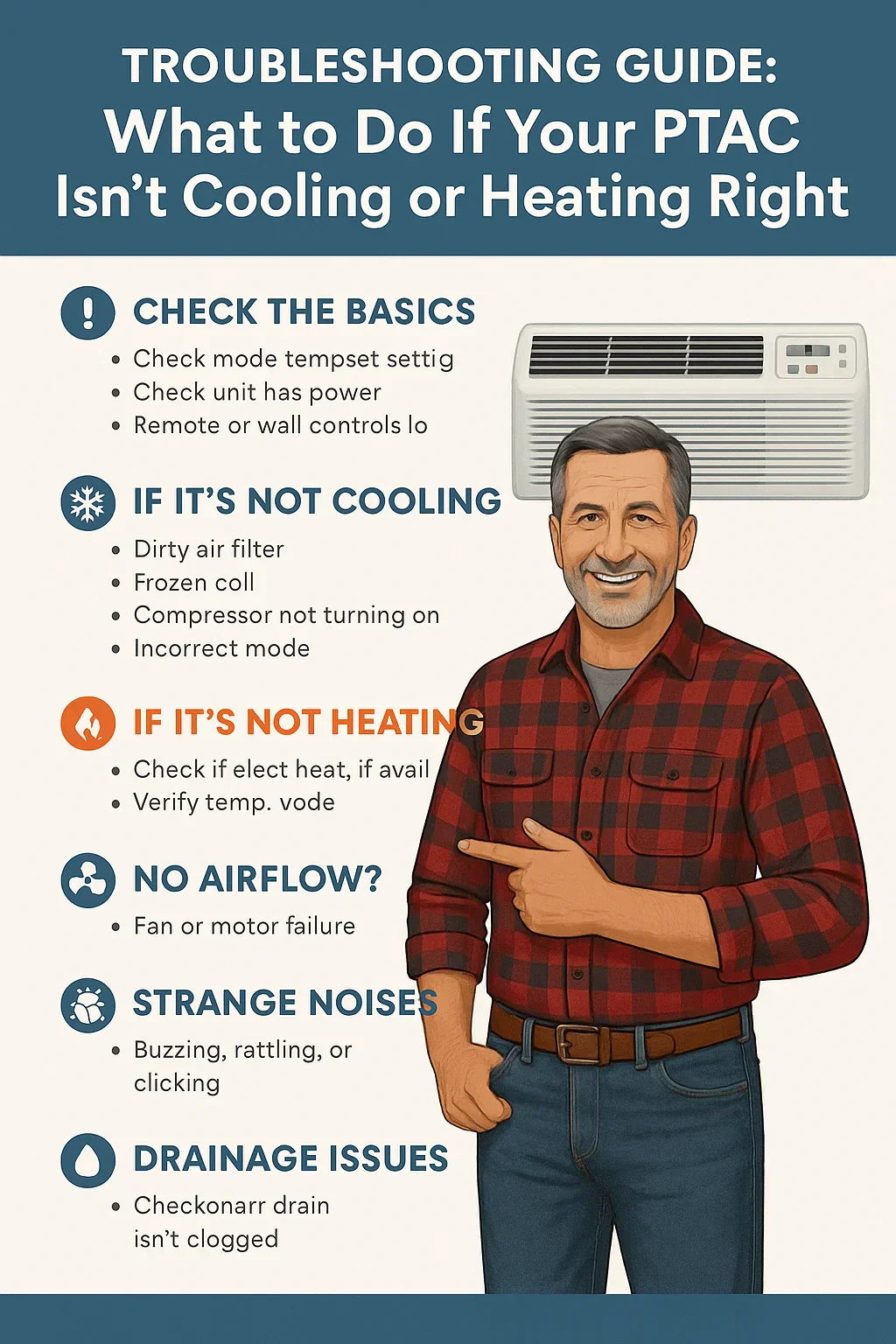PTAC not working properly? Whether it's not cooling, not heating, or just acting up, this step-by-step guide helps you troubleshoot your PTAC unit like a pro — before you call for service.
Intro: When Your PTAC Leaves You Sweating (or Freezing)
Nothing’s worse than turning on your PTAC and realizing it’s not doing its job — especially in extreme heat or cold. If your unit is blowing warm air when you want cool (or vice versa), don’t panic just yet. This guide walks you through common PTAC problems, how to diagnose them, and what you can do before calling in a technician.
1. Is It Really the PTAC’s Fault? Check These Basics First
-
Thermostat Settings:
Make sure the unit is set to the correct mode (cool/heat) and not just blowing fan air. -
Power Issues:
Is the unit plugged in? Has a breaker tripped? PTACs often share circuits with other appliances. -
Remote or Wall Controls:
Some PTACs have separate thermostats or remotes — double-check batteries and sync.
2. If It’s Not Cooling: Top Reasons and Fixes
-
Dirty Air Filter
➤ Fix: Remove and clean or replace the filter (should be done every 30 days). -
Frozen Coil
➤ Fix: Turn off the unit and let it thaw. This usually happens from low airflow or refrigerant issues. -
Compressor Not Engaging
➤ Fix: Listen for the compressor "kick on." If silent, it could be a capacitor or control board issue. -
Incorrect Mode
➤ Fix: Make sure it’s not set to “Fan Only” or “Energy Saver” mode.
3. If It’s Not Heating: Top Causes to Rule Out
-
Wrong Heat Source Selected
➤ PTACs with both electric heat and heat pump modes may default to the wrong setting. -
Tripped Heat Strip Sensor or Safety Cutoff
➤ Fix: Power cycle the unit. If it trips again, an internal issue may need repair. -
Outdoor Temps Too Low for Heat Pump Mode
➤ Fix: If it’s freezing outside, switch to electric heat if available.
4. No Airflow at All? Fan or Motor May Be the Culprit
-
Blower Motor Failure
➤ Fix: Listen for any sound. If silent, the motor may need replacement. -
Fan Obstruction
➤ Fix: Check for debris or insects in the blower housing (yes, it happens!). -
Wiring Issues or Faulty Control Board
➤ Fix: Check for burnt smells or tripped breakers.
5. Common PTAC Error Codes and What They Mean
| Error Code | Likely Issue | DIY Fix? |
|---|---|---|
| E1 | Thermistor open/faulty | No – call service |
| E2 | Indoor coil sensor issue | Possibly – check sensor placement |
| E9 | Water leak or overflow | Yes – empty pan, clear drain |
| F1 | Filter alert | Yes – clean filter |
6. If You Hear These Noises, Something’s Up
-
Buzzing = Likely electrical issue or stuck relay
-
Clicking without ignition = Control board or thermostat failure
-
Rattling = Debris inside or loose fan blade
7. Drainage Problems Can Trigger Cooling or Heating Issues Too
-
Clogged Condensate Drain
➤ Water backup can shut off cooling or heating as a safety feature. Clear drain with vinegar or compressed air. -
Improper Tilt or Installation
➤ PTACs should slope slightly outward to ensure proper drainage. Fix with shims if needed.
8. Is It Time to Call for Help? Here’s When to Contact a Pro
-
The unit is leaking refrigerant (you’ll usually smell it or see oily residue).
-
Compressor doesn’t turn on after 3+ reset attempts.
-
You see error codes you can’t clear, or breakers keep tripping.
-
The unit is more than 10–12 years old and acting up frequently.
9. Preventive Tips So It Doesn’t Happen Again
-
Clean filters monthly
-
Vacuum intake grills and coil areas every season
-
Ensure good clearance around outdoor vents
-
Have it professionally serviced annually if used year-round
Conclusion: Most Issues Are Fixable — Even Without a Technician
While PTACs are simpler than central HVAC, they still need care and attention. By learning the basics of how they work and what to check when things go wrong, you can save time, money, and avoid sleepless nights in sweltering heat or frigid temps.
Need a replacement PTAC or parts?
Check out the top-selling PTACs at The Furnace Outlet — with real-world reviews and specs Mike would trust.
In the next topic we will know more about: PTAC vs. Mini Split: Why Mike Chose a PTAC for His Small Rental Unit







